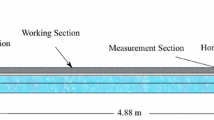Abstract
A pressure-driven two-layer channel flow of a Newtonian fluid with constant viscosity (top layer) and a fluid with a time-dependent viscosity (bottom layer) is numerically investigated. The bottom layer goes through an ageing process in which its viscosity increases due to the formation of internal structure, which is represented by a Coussot-type relationship. The resultant flow dynamics is the consequence of the competition between structuration and de-structuration, as characterised by the dimensionless timescale for structuration \((\tau )\) and the dimensionless material property \((\beta )\) of the bottom fluid. The development of Kelvin-Helmholtz type instabilities (roll-up structures) observed in the Newtonian constant viscosity case was found to be suppressed as the viscosity of the bottom layer increased over time. It is found that, for the set of parameters considered in the present study, the bottom layer almost behaves like a Newtonian fluid with constant viscosity for \(\tau >10\) and \(\beta >1\). It is also shown that decreasing the value of the Froude number stabilises the interfacial instabilities. The wavelength of the interfacial wave increases as the capillary number increases.









Similar content being viewed by others
References
Engelund F, Zhaohui W (1984) Instability of hyperconcentrated flow. J Hydraul Eng 110:219
Kelly WE, Nacci VA, Gularte RC (1979) Erosion of cohesive sediments as rate process. J Geotech Eng Div 105:673
Nguyen QD, Boger DV (1985) Thixotropic behaviour of concentrated bauxite residue suspensions. Rheol Acta 24:427
Lapasin R, Papo A, Rajgelj S (1983) Flow behavior of fresh cement pastes. A comparison of different rheological instruments and techniques. Cem Concr Res 13:349
Weinstein SJ, Ruschak KJ (2004) Coating flows. Ann Rev Fluid Mech 36:29
Ramirez-Jaramillo E, Lira-Galeana C, Manero O (2006) Modeling asphaltene deposition in production pipelines. Energy and fuels 20:1184
Boek ES, Ladva HK, Crawshaw JP, Padding JT (2008) Deposition of colloidal asphaltene in capillary flow: experiments and mesoscopic simulation. Energy and fuels 22:805
Mewis J, Wagner NJ (2009) Thixotropy. Adv Coll Interf Sci 147:214
Govindarajan R, Sahu KC (2014) Instabilities in viscosity-stratified flows. Ann Rev Fluid Mech 46:331
Toorman EA (1997) Modelling the thixotropic behaviour of dense cohesive sediment suspensions. Rheol Acta 36:56
Mitchell RJ, Markell AR (1974) Flow sliding in sensitive soils. Can Geotech J 11:11
Coussot P, Roussel N, Jarny S, Chanson H (2005) Continuous or catastrophic solid-liquid transition in jammed systems. Phys Fluids 17:011704
Huynh HT, Roussel N, Coussot P (2005) Aging and free surface flow of a thixotropic fluid. Phys Fluids 17:033101
Roussel N, Le Roy R, Coussot P (2004) Thixotropy modelling at local and macroscopic scales. J Non-Newtonian Fluid Mech 117:85
Joseph DD, Bai R, Chen KP, Renardy YY (1997) Core-annular flows. Ann Rev Fluid Mech 29:65
Yih CS (1967) Instability due to viscous stratification. J Fluid Mech 27:337
Yiantsios SG, Higgins BG (1988) Linear stability of plane Poiseuille flow of two superposed fluids. Phys Fluids 31:3225
Hooper AP, Boyd WGC (1983) Shear flow instability at the interface between two fluids. J Fluid Mech 128:507
Boomkamp PAM, Miesen RHM (1996) Classification of instabilities in parallel two-phase flow. Int J Multiphase Flow 22:67
Kao TW, Park C (1972) Experimental investigations of the stability of channel flows. Part 2. Two-layered co-current flow in a rectangular channel. J Fluid Mech 52:401
Valluri P, Náraigh L, Ding H, Spelt PDM (2010) Linear and nonlinear spatio-temporal instability in laminar two-layer flows. J Fluid Mech 656:458
Redapangu PR, Sahu KC (2012) Multiphase lattice Boltzmann simulations of buoyancy-induced flow of two immiscible fluids with different viscosities. Eur J Mech B/Fluids 34:105
Redapangu PR, Sahu KC, Vanka SP (2012) study of pressure-driven displacement flow of two immiscible liquids using a multiphase lattice Boltzmann approach. Phys Fluids 24:102110
Frigaard IA (2001) Super-stable parallel flows of multiple visco-plastic fluids. J Non-Newt Fluid Mech 100:49
Taghavi SM, Séon T, Martinez DM, Frigaard IA (2011) Stationary residual layers in buoyant Newtonian displacement flows. Phys Fluids 23:044105
Taghavi SM, Alba K, Séon T, Wielage-Burchard K, Martinez DM, Frigaard IA (2012) Miscible displacement flows in near-horizontal ducts at low Atwood number. J Fluid Mech 696:175
Hormozi S, Wielage-Burchard K, Frigaard IA (2011) Entry, start up and stability effects in visco-plastically lubricated pipe flows. J Fluid Mech 673:432
Taghavi SM, Séon T, Martinez DM, Frigaard IA (2009) Buoyancy-dominated displacement flows in near-horizontal channels: the viscous limit. J Fluid Mech 639:1
Sahu KC, Ding H, Valluri P, Matar OK (2009a) Linear stability analysis and numerical simulation of miscible channel flows. Phys Fluids 21:042104
Sahu KC, Ding H, Valluri P, Matar OK (2009b) Prssure-driven miscible two-fluid channel flow with density gradients. Phys Fluids 21:043603
Sahu KC, Valluri P, Spelt PDM, Matar OK (2007) Linear instability of pressure-driven channel flow of a Newtonian and Herschel-Bulkley fluid. Phys Fluids 19:122101
Sahu KC, Matar OK (2010) Three-dimensional linear instability in pressure-driven two-layer channel flow of a Newtonian and a Herschel-Bulkley fluid. Phys Fluids 22:122103
Sileri D, Sahu KC, Matar OK (2011) Two-fluid pressure-driven channel flow with wall deposition and ageing effects. J Eng Math 71:109
Ding H, Spelt PDM, Shu C (2007) Diffuse interface model for incompressible two-phase flows with large density ratios. J Comput Phys 226:2078
Xu ZL, Chen JY, Liu HR, Sahu KC, Ding H (2021) Motion of self-rewetting drop on a substrate with a constant temperature gradient. J Fluid Mech 915:A116
Acknowledgements
I am grateful to Prof. Subhasish Dey (Guest Editor, Special Issue of Environmental Fluid Mechanics: Hydrodynamic and Fluvial Instabilities) for inviting me to contribute an article to this special issue. I also thank Mounika Balla for her help to plot some figures. The financial support from Science and Engineering Research Board, India through grant no. MTR/2017/000029 is gratefully acknowledged.
Author information
Authors and Affiliations
Corresponding author
Additional information
Publisher's Note
Springer Nature remains neutral with regard to jurisdictional claims in published maps and institutional affiliations.
Rights and permissions
About this article
Cite this article
Sahu, K.C. Two-layer channel flow involving a fluid with time-dependent viscosity. Environ Fluid Mech 22, 263–274 (2022). https://doi.org/10.1007/s10652-021-09803-8
Received:
Accepted:
Published:
Issue Date:
DOI: https://doi.org/10.1007/s10652-021-09803-8




